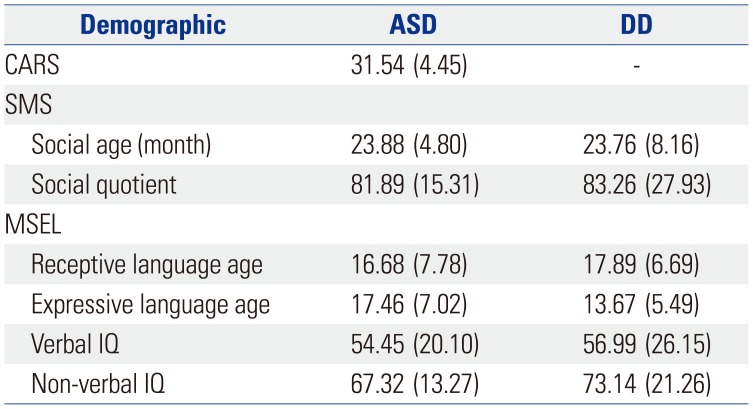1. Ninio A, Snow CE. Pragmatic development. New York: Westview Press;1996.
2. Chericoni N, de Brito Wanderley D, Costanzo V, Diniz-Gonçalves A, Leitgel Gille M, Parlato E, et al. Pre-linguistic vocal trajectories at 6-18 months of age as early markers of autism. Front Psychol. 2016; 7:1595. PMID:
27807424.

3. Patten E, Belardi K, Baranek GT, Watson LR, Labban JD, Oller DK. Vocal patterns in infants with autism spectrum disorder: canonical babbling status and vocalization frequency. J Autism Dev Disord. 2014; 44:2413–2428. PMID:
24482292.

4. Hale CM, Tager-Flusberg H. Brief report: the relationship between discourse deficits and autism symptomatology. J Autism Dev Disord. 2005; 35:519–524. PMID:
16134037.

5. Mitchell S, Cardy JO, Zwaigenbaum L. Differentiating autism spectrum disorder from other developmental delays in the first two years of life. Dev Disabil Res Rev. 2011; 17:130–140. PMID:
23362032.

6. Ozonoff S, Iosif AM, Baguio F, Cook IC, Hill MM, Hutman T, et al. A prospective study of the emergence of early behavioral signs of autism. J Am Acad Child Adolesc Psychiatry. 2010; 49:256–266. 266.e1–266.e2. PMID:
20410715.

7. Scherer KR. The assessment of vocal expression in infants and children. In : Izard C, editor. Measuring emotions in infants and children. Cambridge, England: Cambridge University Press;1982. p. 127–163.
8. Estes A, Munson J, Rogers SJ, Greenson J, Winter J, Dawson G. Long-term outcomes of early intervention in 6-year-old children with autism spectrum disorder. J Am Acad Child Adolesc Psychiatry. 2015; 54:580–587. PMID:
26088663.

9. Hutman T, Rozga A, DeLaurentis AD, Barnwell JM, Sugar CA, Sigman M. Response to distress in infants at risk for autism: a prospective longitudinal study. J Child Psychol Psychiatry. 2010; 51:1010–1020. PMID:
20546081.

10. Lee KS, Jung SJ, Cho SW, Shin YJ, Jeon MK, Ahn SI. Application of SACS-K to Korean infants and toddlers with autism spectrum disorders (ASD): comparison of markers between ASD, developmental delay and typical children. J Korean Assoc Pers Austism. 2016; 16:1–26.
11. Cho SS, Kim SH, Cho SW. Communicative intents in Koreanspeaking typical and autistic children. In : Proceedings of the 5th International Conference of the Cognitive Science; 2006 Jul 26-29; Vancouver, Canada. Seoul: Sigma Press;2008. p. 83–84.
12. American Psychiatric Association. Diagnostic and statistical manual of mental disorders. 4th ed. Washington, DC: American Psychiatric Association;1994.
13. Shneidman ES. Review of vineland social maturity scale. [Review of the book vineland social maturity scale. E.A. Doll]. J Consult Psychol. 1956; 20:409–410.
14. Shank L. Mullen scales of early learning. In : Kreutzer JS, DeLuca J, Caplan B, editors. Encyclopedia of clinical neuropsychology. New York (NY): Springer;2011. p. 1669–1671.
15. Schopler E, Van Bourgondien ME, Wellman , GJ , Love SR. Childhood autism rating scale. 2nd ed. Los Angeles: Western Psychological Services;2010.
16. MacWhinney B. The CHILDES project. 3rd ed. Mahwah (NJ): Lawrence Erlbaum;2014.
17. Schoen E, Paul R, Chawarska K. Phonology and vocal behavior in toddlers with autism spectrum disorders. Autism Res. 2011; 4:177–188. PMID:
21308998.

18. Ekman P. An argument for basic emotions. Cogn Emot. 1992; 6:169–200.

19. Allely CS. Pain sensitivity and observer perception of pain in individuals with autistic spectrum disorder. ScientificWorldJournal. 2013; 2013:916178. PMID:
23843740.

20. Clifford S, Dissanayake C. Dyadic and triadic behaviours in infancy as precursors to later social responsiveness in young children with autistic disorder. J Autism Dev Disord. 2009; 39:1369–1380. PMID:
19475503.

21. Striano T, Stahl D. Sensitivity to triadic attention in early infancy. Dev Sci. 2005; 8:333–343. PMID:
15985067.

22. Volkmar FR, Klin A, Siegel B, Szatmari P, Lord C, Campbell M, et al. Field trial for autistic disorder in DSM-IV. Am J Psychiatry. 1994; 151:1361–1367. PMID:
8067493.
23. Hobson RP. The autistic child's appraisal of expressions of emotion. J Child Psychol Psychiatry. 1986; 27:321–342. PMID:
3733915.

24. Hobson RP, Ouston J, Lee A. What's in a face? The case of autism. Br J Psychol. 1988; 79(Pt 4):441–453. PMID:
3208000.

25. Hobson RP. The emotional origins of social understanding. Philos Psychol. 1993; 6:227–245.

26. Loveland KA. Social affordances and interaction II: autism and the affordances of the human environment. Ecol Psychol. 1991; 3:99–119.










 PDF
PDF ePub
ePub Citation
Citation Print
Print



 XML Download
XML Download